【英语】英语语法现在进行时归纳总结
- 格式:doc
- 大小:63.50 KB
- 文档页数:8
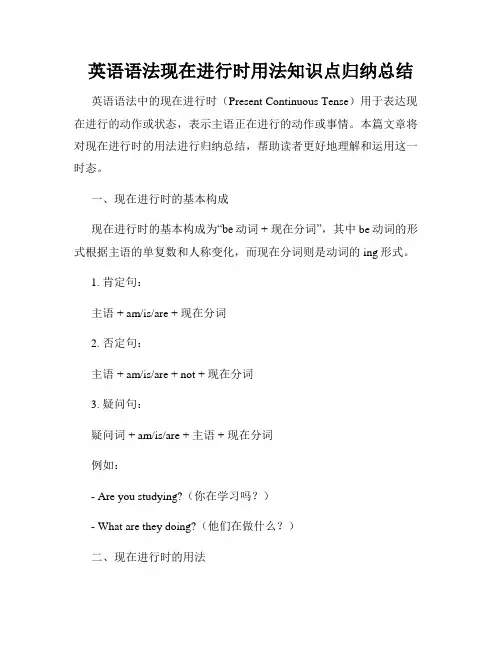
英语语法现在进行时用法知识点归纳总结英语语法中的现在进行时(Present Continuous Tense)用于表达现在进行的动作或状态,表示主语正在进行的动作或事情。
本篇文章将对现在进行时的用法进行归纳总结,帮助读者更好地理解和运用这一时态。
一、现在进行时的基本构成现在进行时的基本构成为“be动词 + 现在分词”,其中be动词的形式根据主语的单复数和人称变化,而现在分词则是动词的ing形式。
1. 肯定句:主语 + am/is/are + 现在分词2. 否定句:主语 + am/is/are + not + 现在分词3. 疑问句:疑问词 + am/is/are + 主语 + 现在分词例如:- Are you studying?(你在学习吗?)- What are they doing?(他们在做什么?)二、现在进行时的用法1. 表示现阶段正在进行或发生的动作或情况:- I am reading a book.(我正在读书。
)- They are watching TV.(他们正在看电视。
)2. 表示现阶段的变化、趋势或动态:- The population of the city is increasing rapidly.(该城市的人口正在迅速增长。
)- The weather is getting warmer.(天气正在变暖。
)3. 表示计划或安排即将发生的动作:- We are going to the cinema tonight.(今晚我们要去电影院。
)- She is leaving for Paris tomorrow.(她明天将前往巴黎。
)4. 表示现阶段的临时状况或固定安排:- I'm staying with my friend until my house is ready.(我的房子准备好之前,我暂时和我的朋友住在一起。
)- They are working on a new project this month.(他们这个月正在进行一个新的项目。
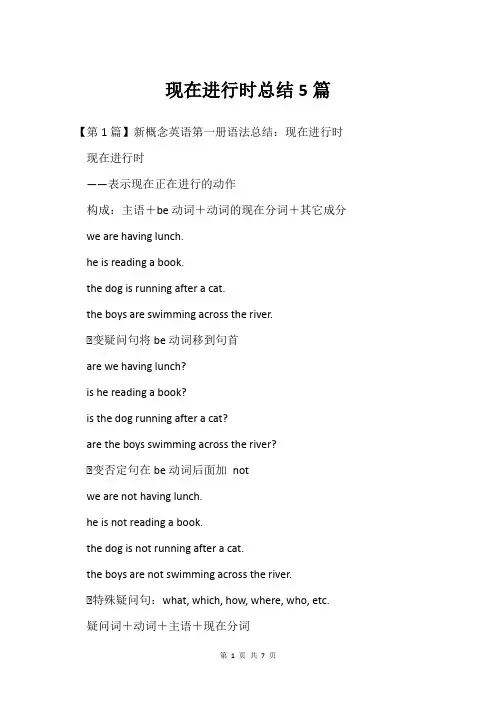
现在进行时总结5篇【第1篇】新概念英语第一册语法总结:现在进行时现在进行时——表示现在正在进行的动作构成:主语+be动词+动词的现在分词+其它成分we are having lunch.he is reading a book.the dog is running after a cat.the boys are swimming across the river.★变疑问句将be动词移到句首are we having lunch?is he reading a book?is the dog running after a cat?are the boys swimming across the river?★变否定句在be动词后面加notwe are not having lunch.he is not reading a book.the dog is not running after a cat.the boys are not swimming across the river.★特殊疑问句:what, which, how, where, who, etc. 疑问词+动词+主语+现在分词what are you doing?what is she doing?what is the dog doing?没有进行时的动词(必背)表示状态,思想,感情和感觉的动词不能表示正在进行的动作:1. 表示感觉,感官的词see, hear, like, love, want2. have, has当“拥有”讲时没有进行时【第2篇】小学英语语法总结大全:现在进行时动词加ing的变化规则1.一般情况下,直接加ing,如:cook-cooking2.以不发音的e结尾,去e加ing,如:make-making, taste-tasting 3.如果末尾是辅音字母加一个元音字母和一个辅音字母,双写末尾的辅音字母,再加ing,如:run-running, stop-stopping现在进行时,用来表示正在进行或发生的动作。
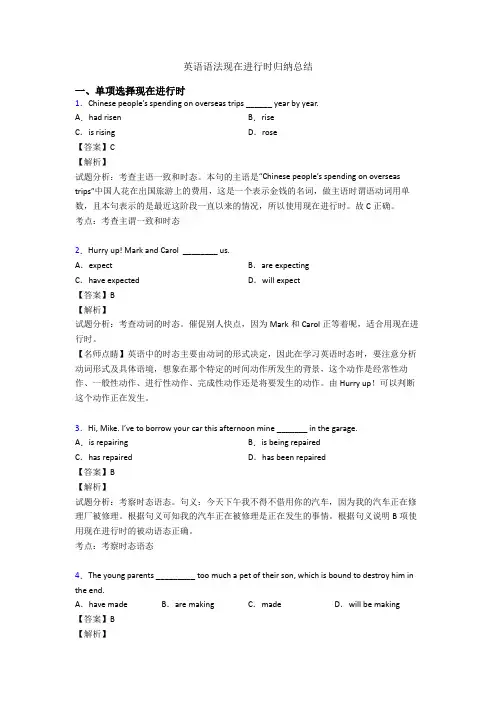
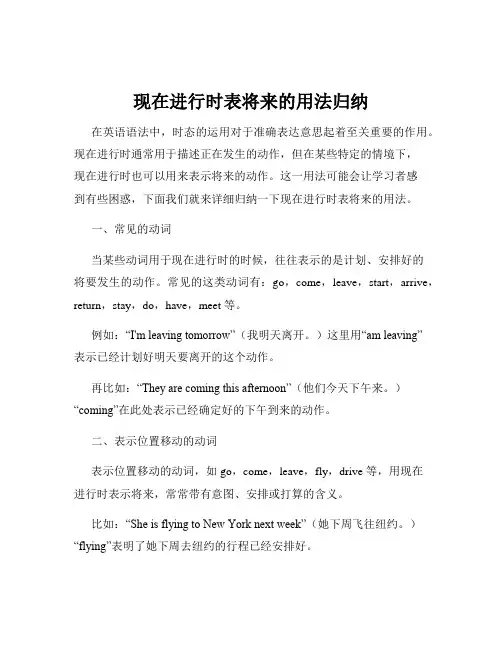
现在进行时表将来的用法归纳在英语语法中,时态的运用对于准确表达意思起着至关重要的作用。
现在进行时通常用于描述正在发生的动作,但在某些特定的情境下,现在进行时也可以用来表示将来的动作。
这一用法可能会让学习者感到有些困惑,下面我们就来详细归纳一下现在进行时表将来的用法。
一、常见的动词当某些动词用于现在进行时的时候,往往表示的是计划、安排好的将要发生的动作。
常见的这类动词有:go,come,leave,start,arrive,return,stay,do,have,meet 等。
例如:“I'm leaving tomorrow”(我明天离开。
)这里用“am leaving”表示已经计划好明天要离开的这个动作。
再比如:“They are coming this afternoon”(他们今天下午来。
)“coming”在此处表示已经确定好的下午到来的动作。
二、表示位置移动的动词表示位置移动的动词,如 go,come,leave,fly,drive 等,用现在进行时表示将来,常常带有意图、安排或打算的含义。
比如:“She is flying to New York next week”(她下周飞往纽约。
)“flying”表明了她下周去纽约的行程已经安排好。
又如:“The bus is leaving in five minutes”(公交车五分钟后出发。
)这里“leaving”清晰地传达了公交车出发的时间是已经确定好的未来时刻。
三、现在进行时表将来的时间状语当现在进行时用于表示将来时,常常会有一些特定的时间状语来加以说明,以便更明确地表达动作发生的时间在未来。
常见的时间状语有:tomorrow,next week,soon,in a few days,in the future 等。
例如:“I'm meeting him tomorrow”(我明天要见他。
)“tomorrow”清晰地指出了见面这个动作发生在明天。
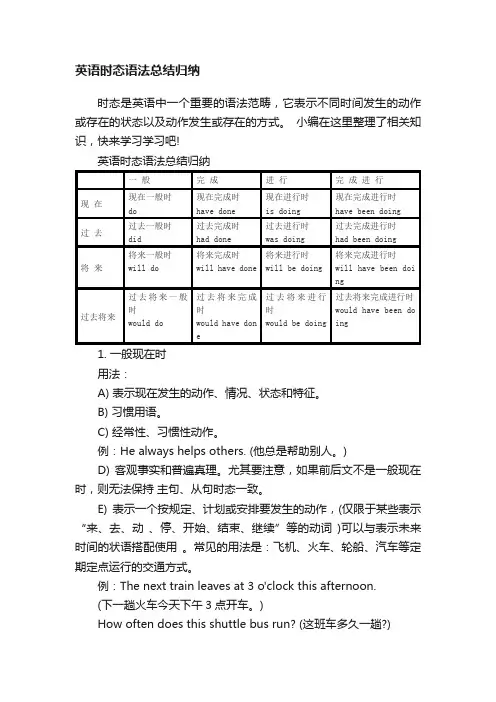
英语时态语法总结归纳时态是英语中一个重要的语法范畴,它表示不同时间发生的动作或存在的状态以及动作发生或存在的方式。
小编在这里整理了相关知识,快来学习学习吧!英语时态语法总结归纳一般完成进行完成进行现在现在一般时do现在完成时have done现在进行时is doing现在完成进行时have been doing过去过去一般时did过去完成时had done过去进行时was doing过去完成进行时had been doing将来将来一般时will do将来完成时will have done将来进行时will be doing将来完成进行时will have been doing过去将来过去将来一般时would do过去将来完成时would have done过去将来进行时would be doing过去将来完成进行时would have been doing1. 一般现在时用法:A) 表示现在发生的动作、情况、状态和特征。
B) 习惯用语。
C) 经常性、习惯性动作。
例:He always helps others. (他总是帮助别人。
)D) 客观事实和普遍真理。
尤其要注意,如果前后文不是一般现在时,则无法保持主句、从句时态一致。
E) 表示一个按规定、计划或安排要发生的动作,(仅限于某些表示“来、去、动、停、开始、结束、继续”等的动词)可以与表示未来时间的状语搭配使用。
常见的用法是:飞机、火车、轮船、汽车等定期定点运行的交通方式。
例:The next train leaves at 3 o'clock this afternoon.(下一趟火车今天下午3点开车。
)How often does this shuttle bus run? (这班车多久一趟?)F) 在时间和条件状语从句里经常用一般现在(有时也用现在完成时)表示将来事情。
例:When you have finished the report, I will have waited for about 3 hours.(等你完成这份报告的时候,我就已经等了将近3个小时了。
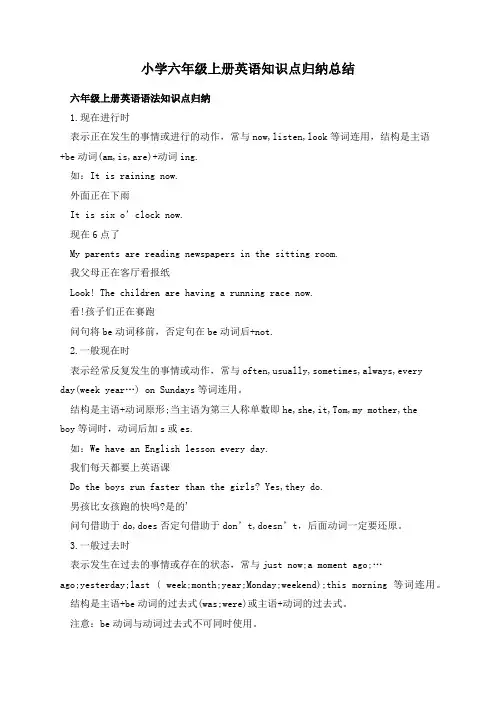
小学六年级上册英语知识点归纳总结六年级上册英语语法知识点归纳1.现在进行时表示正在发生的事情或进行的动作,常与now,listen,look等词连用,结构是主语+be动词(am,is,are)+动词ing.如:It is raining now.外面正在下雨It is six o’clock now.现在6点了My parents are reading newspapers in the sitting room.我父母正在客厅看报纸Look! The children are having a running race now.看!孩子们正在赛跑问句将be动词移前,否定句在be动词后+not.2.一般现在时表示经常反复发生的事情或动作,常与often,usually,sometimes,always,every day(week year…) on Sundays等词连用。
结构是主语+动词原形;当主语为第三人称单数即he,she,it,Tom,my mother,theboy等词时,动词后加s或es.如:We have an English lesson every day.我们每天都要上英语课Do the boys run faster than the girls? Yes,they do.男孩比女孩跑的快吗?是的'问句借助于do,does否定句借助于don’t,doesn’t,后面动词一定要还原。
3.一般过去时表示发生在过去的事情或存在的状态,常与just now;a moment ago;…ago;yesterday;last ( week;month;year;Monday;weekend);this morning等词连用。
结构是主语+be动词的过去式(was;were)或主语+动词的过去式。
注意:be动词与动词过去式不可同时使用。
如:My earphones were on the ground just now.我的耳机刚刚还在呢。
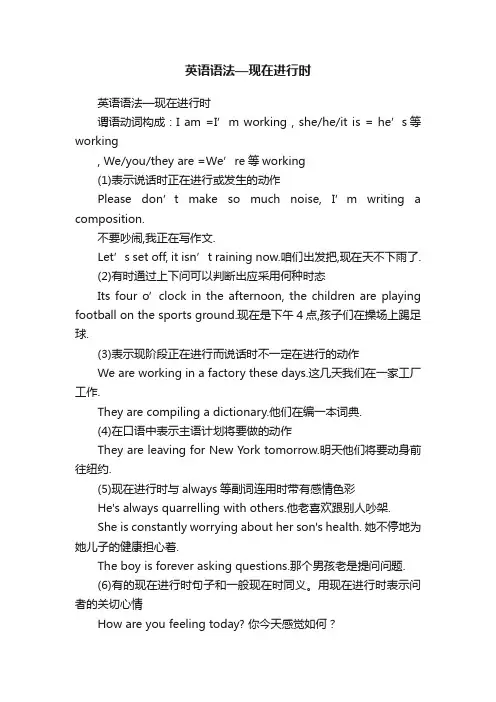
英语语法—现在进行时英语语法—现在进行时谓语动词构成:I am =I’m working , she/he/it is = he’s等working, We/you/they are =We’re等working(1)表示说话时正在进行或发生的动作Please don’t make so much noise, I’m writing a composition.不要吵闹,我正在写作文.Let’s set off, it isn’t raining now.咱们出发把,现在天不下雨了.(2)有时通过上下问可以判断出应采用何种时态Its four o’clock in the afternoon, the children are playing football on the sports ground.现在是下午4点,孩子们在操场上踢足球.(3)表示现阶段正在进行而说话时不一定在进行的动作We are working in a factory these days.这几天我们在一家工厂工作.They are compiling a dictionary.他们在编一本词典.(4)在口语中表示主语计划将要做的动作They are leaving for New York tomorrow.明天他们将要动身前往纽约.(5)现在进行时与always等副词连用时带有感情色彩He's always quarrelling with others.他老喜欢跟别人吵架.She is constantly worrying about her son's health. 她不停地为她儿子的健康担心着.The boy is forever asking questions.那个男孩老是提问问题.(6)有的现在进行时句子和一般现在时同义。
用现在进行时表示问者的关切心情How are you feeling today? 你今天感觉如何?I am looking forward to your next visit.我盼望你下次再来.Why are you looking so sad? 为什么你看起来这么愁眉苦脸的样子呢?(7)有的动词用于现在进行时表示“逐渐”的含义Our study is becoming more interesting. 我们的学习变得越来越有趣了.The leaves are turning red. 树叶渐渐地变红了.Wait a moment, I am finishing my supper. 等一会儿,我的晚饭就要吃完了.(8)“be”动词的现在进行时。
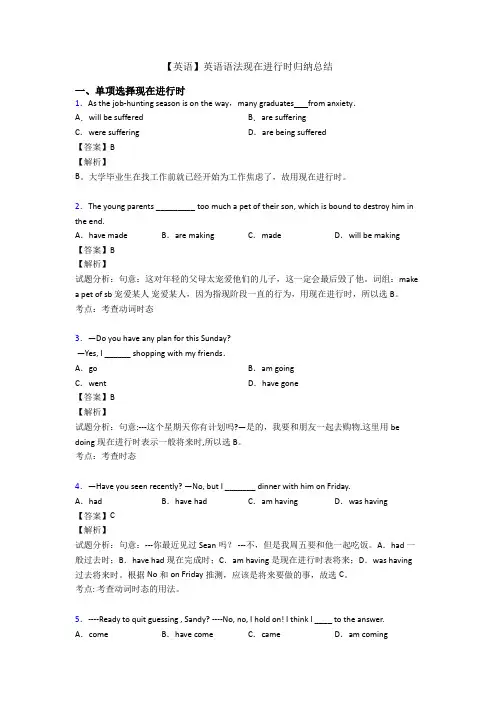
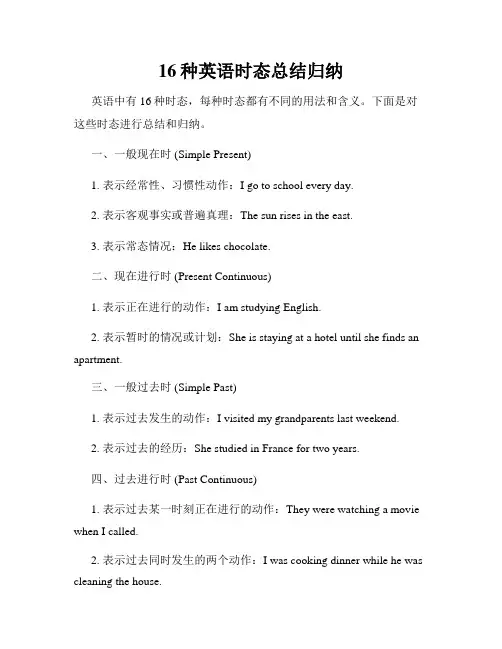
16种英语时态总结归纳英语中有16种时态,每种时态都有不同的用法和含义。
下面是对这些时态进行总结和归纳。
一、一般现在时 (Simple Present)1. 表示经常性、习惯性动作:I go to school every day.2. 表示客观事实或普遍真理:The sun rises in the east.3. 表示常态情况:He likes chocolate.二、现在进行时 (Present Continuous)1. 表示正在进行的动作:I am studying English.2. 表示暂时的情况或计划:She is staying at a hotel until she finds an apartment.三、一般过去时 (Simple Past)1. 表示过去发生的动作:I visited my grandparents last weekend.2. 表示过去的经历:She studied in France for two years.四、过去进行时 (Past Continuous)1. 表示过去某一时刻正在进行的动作:They were watching a movie when I called.2. 表示过去同时发生的两个动作:I was cooking dinner while he was cleaning the house.五、一般将来时 (Simple Future)1. 表示将要发生的动作:I will meet you at the park tomorrow.2. 表示决定或打算:We are going to have a party next weekend.六、将来进行时 (Future Continuous)1. 表示将来某一时刻正在进行的动作:They will be traveling to Europe this time next year.2. 表示持续性的动作:I will be working late tonight.七、现在完成时 (Present Perfect)1. 表示过去发生但与现在有关的动作:I have finished my homework.2. 表示经历或经验:He has traveled to many countries.八、过去完成时 (Past Perfect)1. 表示在过去某一时刻之前已经完成的动作:They had already left when I arrived.2. 表示顺序:She had read the book before watching the movie.九、将来完成时 (Future Perfect)1. 表示将来某一时刻之前完成的动作:I will have finished my project by tomorrow.2. 表示结果:They will have arrived by the time we get there.十、现在完成进行时 (Present Perfect Continuous)1. 表示从过去某一时刻开始一直持续到现在的动作:I have been studying for three hours.2. 表示强调动作的持续性:He has been working all day.十一、过去完成进行时 (Past Perfect Continuous)1. 表示过去某一时刻之前一直持续到过去的动作:She had been waiting for two hours when the bus finally arrived.2. 表示强调动作的持续性:They had been playing tennis all afternoon.十二、将来完成进行时 (Future Perfect Continuous)1. 表示将来某一时刻之前持续进行的动作:I will have been studying for five hours by the time the exam starts.2. 表示强调动作的持续性:They will have been working on the project for a month.十三、虚拟现在时 (Present Unreal)1. 表示与现在事实相反的假设:If I were rich, I would buy a mansion.2. 表示建议或要求:I suggest that he study more.十四、虚拟过去时 (Past Unreal)1. 表示与过去事实相反的假设:If I had studied harder, I would have passed the exam.2. 表示遗憾或后悔:I wish I had bought that dress.十五、虚拟将来时 (Future Unreal)1. 表示与将来事实相反的假设:If I won the lottery, I would travel the world.2. 表示不可能实现的愿望:I wish she would become a famous singer.十六、过去将来时 (Future in the Past)1. 表示过去某一时刻之后将要发生的动作:He said he would call me later.2. 表示过去的计划:I thought we were going to have dinner together.以上是对16种英语时态的总结归纳。
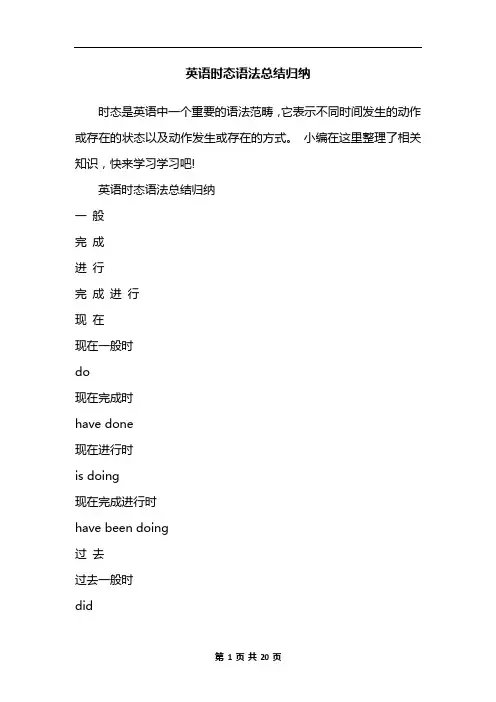
英语时态语法总结归纳时态是英语中一个重要的语法范畴,它表示不同时间发生的动作或存在的状态以及动作发生或存在的方式。
小编在这里整理了相关知识,快来学习学习吧!英语时态语法总结归纳一般完成进行完成进行现在现在一般时do现在完成时have done现在进行时is doing现在完成进行时have been doing过去过去一般时did过去完成时had done过去进行时was doing过去完成进行时had been doing将来将来一般时will do将来完成时will have done将来进行时will be doing将来完成进行时will have been doing 过去将来过去将来一般时would do过去将来完成时would have done过去将来进行时would be doing过去将来完成进行时would have been doing1. 一般现在时用法:A) 表示现在发生的动作、情况、状态和特征。
B) 习惯用语。
C) 经常性、习惯性动作。
例:He always helps others. (他总是帮助别人。
)D) 客观事实和普遍真理。
尤其要注意,如果前后文不是一般现在时,则无法保持主句、从句时态一致。
E) 表示一个按规定、计划或安排要发生的动作,(仅限于某些表示来、去、动、停、开始、结束、继续等的动词)可以与表示未来时间的状语搭配使用。
常见的用法是:飞机、火车、轮船、汽车等定期定点运行的交通方式。
例:The next train leaves at 3 oclock this afternoon.(下一趟火车今天下午3点开车。
)How often does this shuttle bus run? (这班车多久一趟?)F) 在时间和条件状语从句里经常用一般现在(有时也用现在完成时)表示将来事情。
例:When you have finished the report, I will have waited for about 3 hours.(等你完成这份报告的时候,我就已经等了将近3个小时了。
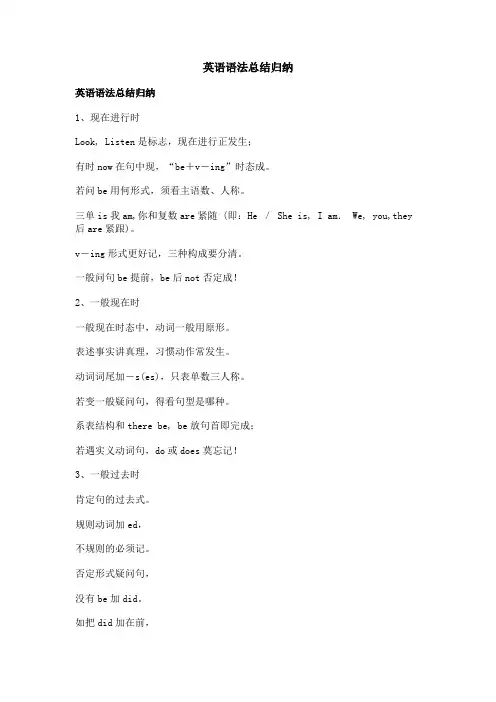
英语语法总结归纳英语语法总结归纳1、现在进行时Look, Listen是标志,现在进行正发生;有时now在句中现,“be+v-ing”时态成。
若问be用何形式,须看主语数、人称。
三单is我am,你和复数are紧随 (即:He / She is, I am. We, you,they 后are紧跟)。
v-ing形式更好记,三种构成要分清。
一般问句be提前,be后not否定成!2、一般现在时一般现在时态中,动词一般用原形。
表述事实讲真理,习惯动作常发生。
动词词尾加-s(es),只表单数三人称。
若变一般疑问句,得看句型是哪种。
系表结构和there be, be放句首即完成;若遇实义动词句,do或does莫忘记!3、一般过去时肯定句的过去式。
规则动词加ed,不规则的必须记。
否定形式疑问句,没有be加did。
如把did加在前,动词还要归原形。
4、基数词变序数词基变序,很容易,一二三,特殊记,th从四起。
八去t来九去e,遇到ve,f 替,ty变为tie,后加th莫迟疑,若想表示几十几,只变个位就可以。
5、时间介词巧记歌年、月、季节前用in,(如:in 2008, in September, in spring)日期前面行不通。
遇到几号或星期改用on来做代替, (如:on January 1,onWedesday)上午、下午、晚上仍用in。
(如:in the morning/afternoon/evening)若是某日上下午,也是用on才能行。
(如:on theevening of the Mid-autumn Day)正午、夜里用at, (如:at noon, at night)时、分用法也同理。
(如:, at two, at two)如若“差”点须加to, (如:two to two)如若“过”点改past。
(如:half past one)多说勤练牢牢记,学好英语非儿戏。
6、特殊的形容词、副词的比较级、最高级一分为二是三个, (指同一个形容词原形但是有两种比较级和最高级形式)两个“远”“来”一个“老”。
现在进行时的知识点归纳1.引言1.1 概述现在进行时是英语语法中的一个时态,用来表示正在进行的动作或状态。
它通常由谓语动词"be"的现在时形式和动词的现在分词构成。
现在进行时又被称为现在进行式。
现在进行时常用于描述此刻正在发生的事情,以及稍后可能会发生的事情。
它可以用来表达说话时的动作、习惯、临时决定等。
在现在进行时中,谓语动词的不同形式取决于主语的人称和数。
例如,当主语是第一人称单数时,谓语动词用"is";当主语是第三人称单数时,谓语动词用"is";当主语是第一或第三人称复数时,谓语动词用"are"。
此外,现在进行时还可以与一些时间状语连用,如"now"、"at the moment"、"currently"等,以强调动作正在进行。
总之,现在进行时与现在的状态和动作密切相关,它能够帮助我们更准确地描述当下正在进行的事情。
在接下来的文章中,我们将详细探讨现在进行时的构成、应用以及需要注意的事项。
1.2 文章结构文章结构是指文章整体的组织框架,它决定了文章的逻辑关系和层次结构。
一个清晰有序的文章结构可以使读者更好地理解文章的内容,并能更好地表达作者的观点和意图。
在本文中,文章结构分为引言、正文和结论三个部分。
1. 引言部分(Introduction)在引言部分,我们需要对现在进行时进行一个概述,简要介绍现在进行时的定义、构成和应用。
同时,我们还需要明确文章的结构和目的,为读者提供一个整体的导引,帮助读者理解和阅读后续的内容。
2. 正文部分(Main Body)正文部分是文章的核心部分,主要讨论和阐述现在进行时的相关知识点。
具体而言,我们可以从以下几个方面展开:2.1 现在进行时的定义在这一部分,我们可以介绍现在进行时的基本概念和定义。
现在进行时主要用于表示当前正在进行的动作或状态,通过be动词(am/is/are)加动词的现在分词形式来构成。
人教版高一英语语法知识点总结_高一英语知识点归纳人教版高一英语知识点总结1【现在进行时】1. 表示现在 (说话瞬间) 正在进行或发生的动作。
[例句] He is reading a newspaper now.2. 表示当前一段时间内的活动或现阶段正在进行的动作 (说话时动作不一定正在进行)。
[例句] What are you doing these days?3. 表示说话人现在对主语的行为表示赞叹或厌恶等, 常与always, constantly, continually等副词连用。
[例句] He is always thinking of others.4. 表示在最近按计划或安排要进行的动作。
常限于go, e, leave, start, arrive等表“移动”、“方向”的词。
[例句] He is ing to see me next week.【过去进行时】1. 表示过去某时正在进行的动作。
[例句] He was sleeping when Mary came to see him.2. 动词go, e, leave, arrive, start等的过去进行时常表过去将来时。
[例句] She said she was going to Beijing the day after tomorrow.人教版高一英语知识点总结2各种时态的被动语态被动语态概述被动语态的概念:它是动词的一种形式,表示主语与谓语之间的执行或被执行关系。
主动语态表示主语是谓语动作的执行者,例如:They saw the little boy crying by the river. 被动语态表示主语是谓语动作的承受者,例如:The little boy was seen crying by the river.被动语态的构成被动语态的形式是由“助动词be+动词的过去分词”构成。
助动词be随着主语的人称、数、时态等的不同而变化。
初中英语语法——现在进行时知识点总结归纳现在进行时是表示现在进行中的动作或状态的一种时态。
它由be动词(am/is/are)+动词的ing形式构成。
下面是现在进行时的一些重要知识点总结和归纳。
1. 现在进行时的基本结构:主语 + am/is/are + 动词-ing + 其他成分。
例如:- I am reading a book.(我正在读一本书。
)- She is playing volleyball.(她正在打排球。
)- They are studying for the exam.(他们正在为考试学习。
)2.现在进行时的用法:-表示现在正在进行的动作或状态。
例如:- He is watching TV.(他正在看电视。
)- They are playing football.(他们正在踢足球。
)-表示现阶段的临时动作。
例如:- She is learning to play the piano.(她正在学弹钢琴。
)- We are staying at the hotel for the night.(我们正在旅馆过夜。
)-表示计划或安排的未来动作。
例如:- I am meeting my friends for lunch tomorrow.(明天我要和朋友们共进午餐。
)- They are going to the beach this weekend.(他们这个周末要去海滩。
)3.否定句和疑问句的构成:- 否定句:主语 + am/is/are + not + 动词-ing + 其他成分。
例如:- He is not working now.(他现在不工作。
)- We are not playing soccer.(我们不在踢足球。
)- 疑问句:Am/Is/Are + 主语 + 动词-ing + 其他成分?例如:- Are you studying for the test?(你在为考试学习吗?)- Is she watching a movie?(她在看电影吗?)4.特殊情况的处理:- 当动词以e结尾时,需将e改为ing。
英语语法16种时态总结在英语学习中,语法是构建语言大厦的基石,而时态则是其中至关重要的一部分。
掌握好英语的 16 种时态,对于准确、流畅地表达思想和理解他人的意图有着举足轻重的作用。
接下来,让我们逐一探讨这16 种时态。
一、一般现在时(Simple Present Tense)一般现在时表示经常发生的动作、习惯性的行为、客观事实或真理等。
其构成是主语+动词原形(当主语是第三人称单数时,动词要加“s”或“es”)。
例如:“I play basketball every weekend”(我每个周末打篮球。
)“He likes reading books”(他喜欢读书。
)这个时态常用于描述日常活动、时间表、科学事实等。
比如:“The sun rises in the east”(太阳从东方升起。
)二、一般过去时(Simple Past Tense)一般过去时用于描述过去发生的动作或存在的状态。
构成是主语+动词的过去式。
像:“I went to Beijing last year”(我去年去了北京。
)“She was happy yesterday”(她昨天很开心。
)常出现在讲述过去的经历、故事、历史事件等语境中。
三、一般将来时(Simple Future Tense)一般将来时表示将来要发生的动作或存在的状态。
常见的构成有“will +动词原形”和“be going to +动词原形”。
比如:“I will visit my grandparents next week”(我下周将去看望我的祖父母。
)“She is going to have a party tomorrow”(她明天要举办一个聚会。
)用于对未来的计划、预测、承诺等。
四、现在进行时(Present Continuous Tense)现在进行时表示正在进行的动作。
结构是“主语+ am/is/are +现在分词”。
像:“I am watching TV now”(我现在正在看电视。
现在进行时元音:a e i o u(其它为辅音)现在进行时表示动作发生的时间是“现在”,动作目前的状态是“正在进行中”。
所谓“正在进行中”,是指在谈到这件事的时候,这个动作还在进行中。
至于它是什么时候开始的,什么时候会停下来,不是我们关心的。
所以“正在进行时”的事件,可能发生几年了,也可能只有几分钟。
仍在进行中这是“正在进行时”的关键所在。
它是一件持续进行的事情。
一.定义:现在进行时的定义:现在进行时表示现在或当前一段时间正在进行的动作.可以表示有计划的未来,也就是用现在进行时表示将来。
二.构成:现在进行时的构成是:主语+be+v。
ing〔现在分词〕形式。
be的变化在现在进行时中,be 要根据人称代词和名词的单复数不同,而分别使用am/is/are,即:I am/he/she/it 包括单数名词和不可数名词用is,you/we/they 包括复数名词用are.第一人称单数:I+am+doing+Sth.第一人称复数We+are+doing +Sth。
第二人称单(复)数 You+are+doing+Sth。
第三人称单数 He(She,it)+is+doing+Sth。
第三人称复数 They+are+doing +Sth。
三.现在进行时的变化肯定句式:主语+be( am, is, are)+现在分词+其它.否定句式:主语+be(am, is, are) +not +现在分词+其它.一般疑问句:Be(am, is, are) +主语+现在分词+其它?特殊疑问句:疑问词+be(am, is, are)+主语+现在分词+其它?对现在进行时的特殊疑问句的回答,它不可以用Yes或No直接作答,要根据实际情况回答。
现在进行时用法口诀主语在句首,am, is, are跟在后,现在分词跟着走,其他成分不可丢。
表示动作正进行,句中now时间定。
一般问句,把be提到句前去。
否定句式也简单,be后只把not添。
四.现在分词加ing的规则现在分词是在动词后加上ing 构成。
英语语法16种英语时态总结,收藏起来慢慢记1. 一般现在时(do/does; is/am/are)①表示现在的情况、状态和特征。
例:He is a student.他是一个学生。
②表示经常性、习惯性动作。
例:He always helps others.他总是帮助别人。
③客观事实和普遍真理。
例:The earth moves the sun.地球绕着太阳转。
④表示一个按规定、计划或安排要发生的动作。
(常用于列车、客车、飞机或轮船时刻表)例:The next train leaves at 3 o'clock this afternoon.下一趟火车今天下午3点开车。
⑤主将从现:在时间、条件和让步状语从句中经常用一般现在表示将的来事情。
例:If it rains tomorrow, we will stay at home.如果明天下雨,我们会待在家里。
2. 现在进行时(am/is/are doing)①表示此时此刻正在发生的事情。
例:He is listning to the music now.他现在正在听音乐。
②表示目前一段时间内一直在做的事情,但不一定此时此刻正在做。
例:I am studying computer this term.这个学期我一直在学习计算机。
③现在进行时可以表示将来的含义。
瞬时动词的进行一定表将来。
例:I am leaving.我要离开了。
持续动词的进行只有有将来的时间状语或有将来语境中才表将来。
例:I am travelling next month.下个月我要去旅行。
④现在进行时与频度副词连用,表示说话者或褒义或贬义的感情色彩。
例:He is always helping others.他总是帮助别人。
(褒义)3. 过去进行时(was/ were doing)①表示在过去一个具体的时间正在发生的动作。
例:Mary was listening to light music 10 minutes ago.10分钟前,玛丽正在听轻音乐。